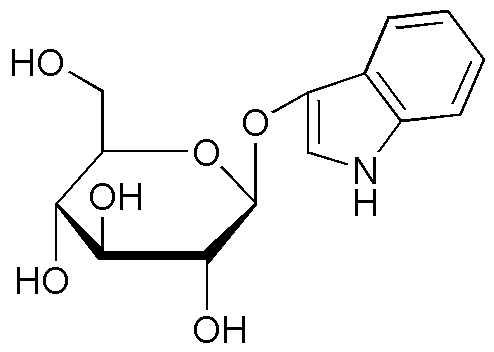Indoxyl b-D-glucoside is widely utilized in research focused on:
- Biochemical Research: This compound serves as a substrate for the enzyme β-glucosidase, making it valuable in studying enzyme kinetics and metabolic pathways.
- Plant Physiology: It is used to investigate indole-related metabolic processes in plants, aiding in understanding plant growth and development.
- Pharmaceutical Development: Indoxyl b-D-glucoside can be explored for its potential therapeutic effects, particularly in the context of anti-inflammatory and antioxidant properties.
- Analytical Chemistry: This compound is employed in various assays to detect and quantify glucosidase activity, providing insights into disease mechanisms.
- Food Industry: It can be used in food research to study the effects of glycosylation on flavor compounds, enhancing flavor profiles in food products.
General Information
Properties
Safety and Regulations
Applications
Indoxyl b-D-glucoside is widely utilized in research focused on:
- Biochemical Research: This compound serves as a substrate for the enzyme β-glucosidase, making it valuable in studying enzyme kinetics and metabolic pathways.
- Plant Physiology: It is used to investigate indole-related metabolic processes in plants, aiding in understanding plant growth and development.
- Pharmaceutical Development: Indoxyl b-D-glucoside can be explored for its potential therapeutic effects, particularly in the context of anti-inflammatory and antioxidant properties.
- Analytical Chemistry: This compound is employed in various assays to detect and quantify glucosidase activity, providing insights into disease mechanisms.
- Food Industry: It can be used in food research to study the effects of glycosylation on flavor compounds, enhancing flavor profiles in food products.
Documents
Safety Data Sheets (SDS)
The SDS provides comprehensive safety information on handling, storage, and disposal of the product.
Product Specification (PS)
The PS provides a comprehensive breakdown of the product’s properties, including chemical composition, physical state, purity, and storage requirements. It also details acceptable quality ranges and the product's intended applications.
Certificates of Analysis (COA)
Search for Certificates of Analysis (COA) by entering the products Lot Number. Lot and Batch Numbers can be found on a product’s label following the words ‘Lot’ or ‘Batch’.
*Catalog Number
*Lot Number
Certificates Of Origin (COO)
This COO confirms the country where the product was manufactured, and also details the materials and components used in it and whether it is derived from natural, synthetic, or other specific sources. This certificate may be required for customs, trade, and regulatory compliance.
*Catalog Number
*Lot Number
Safety Data Sheets (SDS)
The SDS provides comprehensive safety information on handling, storage, and disposal of the product.
DownloadProduct Specification (PS)
The PS provides a comprehensive breakdown of the product’s properties, including chemical composition, physical state, purity, and storage requirements. It also details acceptable quality ranges and the product's intended applications.
DownloadCertificates of Analysis (COA)
Search for Certificates of Analysis (COA) by entering the products Lot Number. Lot and Batch Numbers can be found on a product’s label following the words ‘Lot’ or ‘Batch’.
*Catalog Number
*Lot Number
Certificates Of Origin (COO)
This COO confirms the country where the product was manufactured, and also details the materials and components used in it and whether it is derived from natural, synthetic, or other specific sources. This certificate may be required for customs, trade, and regulatory compliance.


